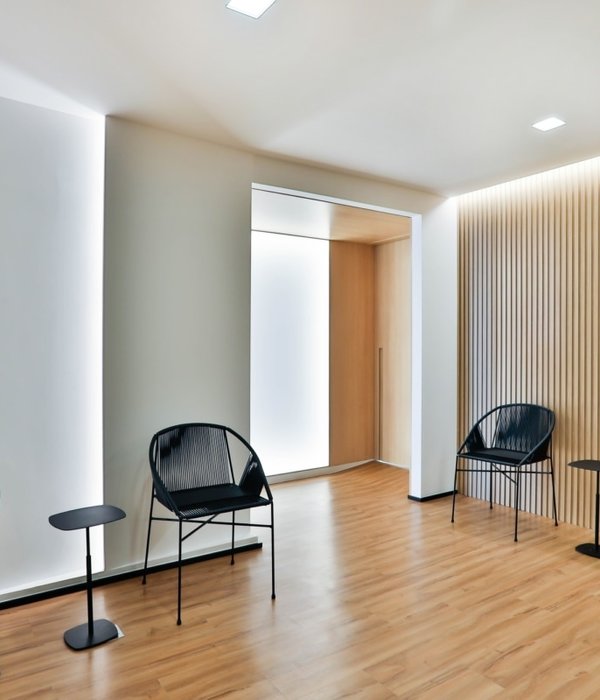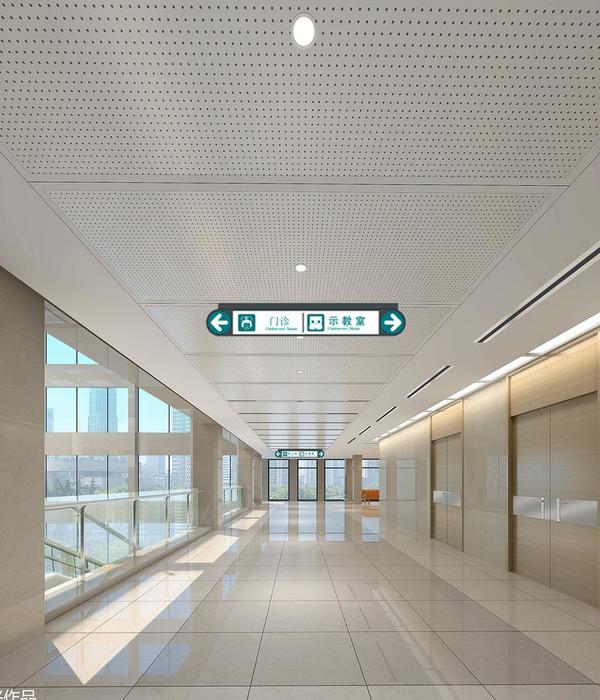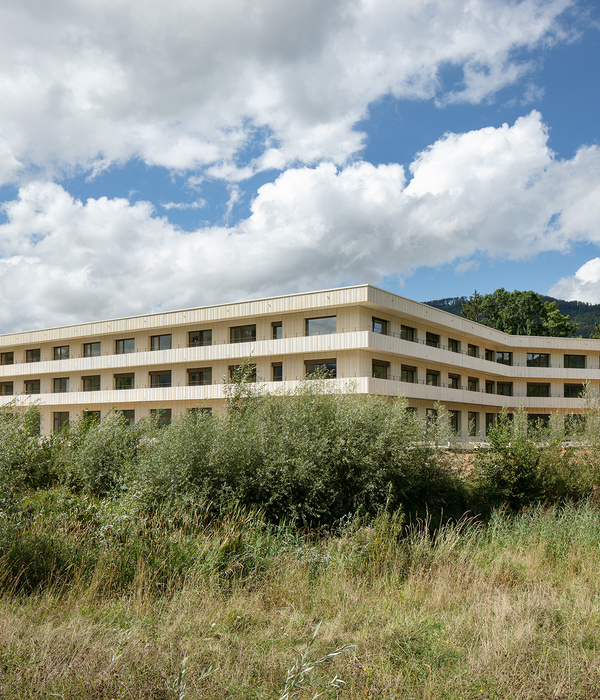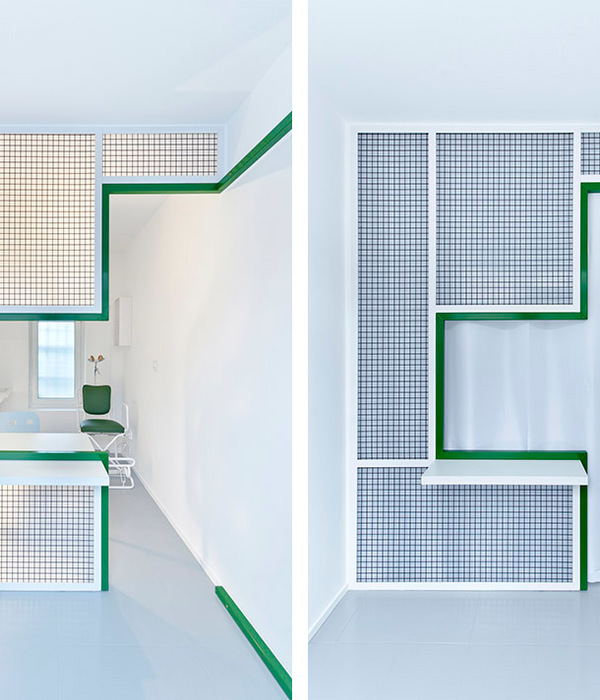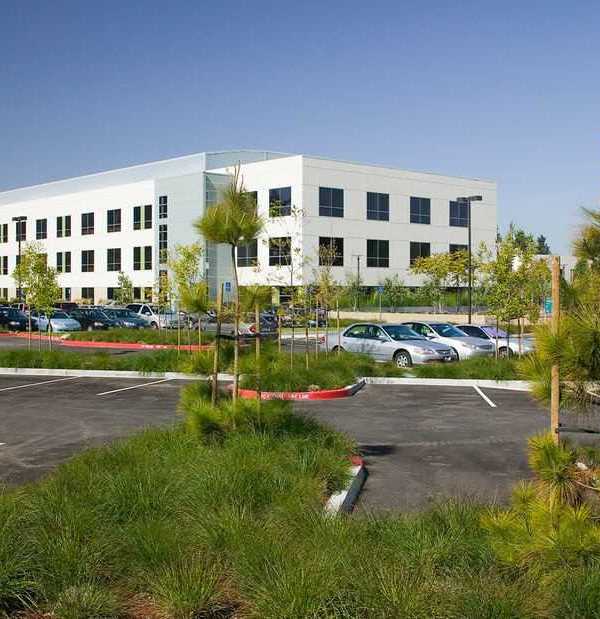项目坐落于日本长野县,是一家专攻生殖医疗的诊所。根据自然能够调节人体周期的医学理念,诊所采用了木制桁架搭建出轻盈通透的天花板层,将天空的景观与充足的阳光引入室内,随着自然光线的变化,建筑的外观也发生微妙的改变。诊所的内部空间几乎没有柱子,大跨度的木桁架结构为自由的平面规划提供了基础。建筑的中心,即平面的对角线上的的桁架横截面最长,且层高也最高为1.7米,对角线两侧随着桁架跨度的减小,高度也发生递减。三维的木制桁架部分充满了空气,形成一个如同“光池”一般的结构层,根据一天内的时间、天气以及季节的变化而变化。半透明的天花板层促进了光线在室内的扩散和反射。
▼项目概览,overall of the project © Shota Kikuchi
This project is a reproductive medical center in Nagano, Japan. Adopting the medical philosophy of adjusting the body cycle naturally, the clinic is layered with a light ceiling that is made of wooden trusses and translucent ceiling layer that change its appearance in every moment according to the provision of natural sunlight. Almost no column is plotted in the internal space, the wooden trusses that span across the building allow free planning. The longest span truss in the center is at maximum height of 1.7m and gradually decreases according to length of each span. The plenum space which carries various air volumes becomes a light pool that changes depending on time of day, weather, and season of the year. The translucent ceiling layer promotes diffusion and reflection of light.
▼北立面,north facade © Shota Kikuchi
▼建筑外观细部,exterior detail © Shota Kikuchi
三峰川在场地的南侧静静地流淌,更远的东南方向则是被称为日本“南阿尔卑斯山”的赤石山脉。场地的形状类似于一个平行四边形,建筑则沿着平行四边形的边缘占满整个地块。从结构的角度来讲,将龙门桁架的轴线设置在对角线形状的短边更为高效,同时这种结构方式也将空间的视野导向风光秀美的东南方向。纤巧的木制墙体与轴线方向保持一致,当人们的视角发生变化时,所能看到的区域范围也随之改变,这种设计同时创造出开放性和封闭性,既保证了景观视野,也兼顾了空间的私密性。
The Mibu River flows to the south of the site, and the Southern Alps mountain range is far to the southeast. The shape of the site is similar to a parallelogram, and the building is laid along to it. Structurally, it is more efficient to set the axis of the gantry trusses to the short side of the diagonal shape and direct the view of the spaces to southeast. The elongated shape wall changes its visible area depending on the line of sight, creating both openness and closure at the same time.
▼通透明亮的等候休息区,transparent and bright waiting area © Shota Kikuchi
▼“光池”一般的天花板层,“Light pool” ceiling layer © Shota Kikuchi
▼纤巧的木制墙体与轴线方向保持一致,The elongated shape wall changes its visible area depending on the line of sight © Shota Kikuchi
等候区域位于面向东南的宽钝角空间,氛围轻松开放;而对私密性要求更高的医疗诊室则位于建筑的西北侧。办公空间是诊所运营的核心,因此位于建筑的中心位置,便于工作人员更加高效与便捷地到达各个不同功能区域。根据场地的形状,对建筑体量进行扭曲,进而在内部创造出不同尺度的功能空间,同时确保了室外所需的停车位的数量。
A relaxing waiting area is placed at the wide obtuse-angled space facing the southeastern view while the medical program rooms which required more enclosed closure are located on the northwest. Since the office space is the core of the clinic operation, it is located in the center of the building for efficient and simpler movement to each room. By distorting the building according to the shape of the site, it creates spaces at required size internally and secures the number of parking spaces required outdoor.
▼诊断区走廊,hallway of the medical program rooms © Shota Kikuchi
▼诊疗市内部,interior of the medical program room © Shota Kikuchi
▼木制桁架室内细部,interior details of the wooden truss structure © OTA Archistudio / Shota Kikuchi
项目所在的城市有80%的面积被森林所覆盖,木材资源丰富,因此除了使用当地木材外,建筑师还希望将整栋建筑交付给当地工匠进行搭建。为了实现这一目标,项目团队设计了一种可由当地市场上流通的标准木材搭建的简单结构形式,并尽可能避免使用特殊加工的层压木材。将90毫米宽的木材分成两半,然后用90毫米的木柱夹在一起,最后用小型螺栓紧固并用冲头连接,便形成了本项目中最主要的木制桁架结构。疫情爆发后,日本木材市场受到了不小的冲击,因此,更应该从长远的角度考虑木造建筑原材料的供应链问题。
80% of the city where the site located is covered by forest. It is not only important to use the local timber but, we also considered how the structure parts can be assembled by local craftsmen. To achieve that, we designed a simple structural form that is possible to be made by standard lumber that is available on the local market and avoid using special processed laminated lumber where possible. The wooden trusses of this building are simply made by splitting the 90mm width lumber into half and sandwiching them together with 90mm wood posts. Then, fastened by minimal bolts and jointed with drift pins. Wood shock has hit Japan since COVID-19, wooden architecture shall consider its supply chain in the long term.
▼夜景,night view © Shota Kikuchi
▼木制桁架搭建现场,Construction site of wooden trusses © Kubota Construction
▼平面图,plans © OTA Archistudio
▼剖面图与立面图,sections and elevations © OTA Archistudio
Architects: Kubota Construction / OTA Archistudio Location: Nagano, Japan Project Year: 2020 Photographs: Shota Kikuchi Area: 447.0 m2 Photographs: Shota Kikuchi Manufacturers: K.I.N., LIXIL / Mitsui Home Components Construction: KUBOTA CONSTRUCTION CORP. Structural Design: Megumi Tamura Structural Factory / Megumi Tamura Lighting Design: Sugio Lighting Design Office / Atsushi Sugio
▼项目更多图片
{{item.text_origin}}


